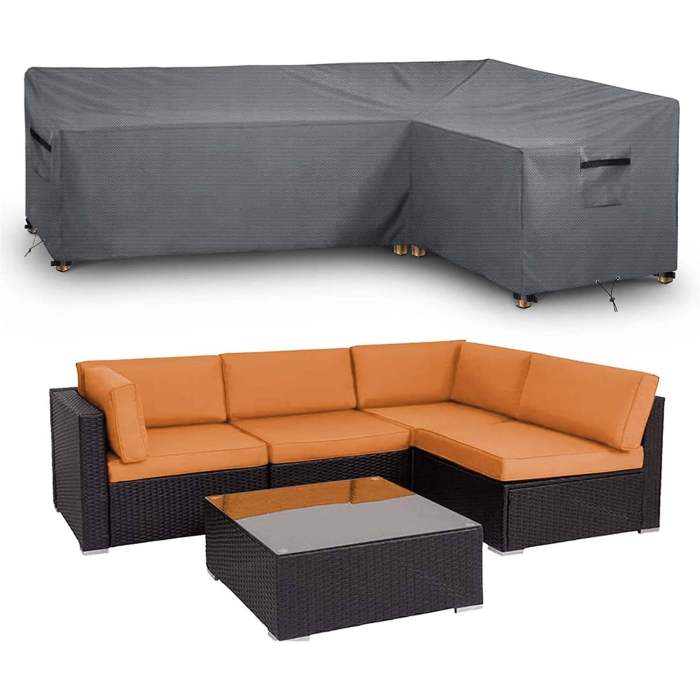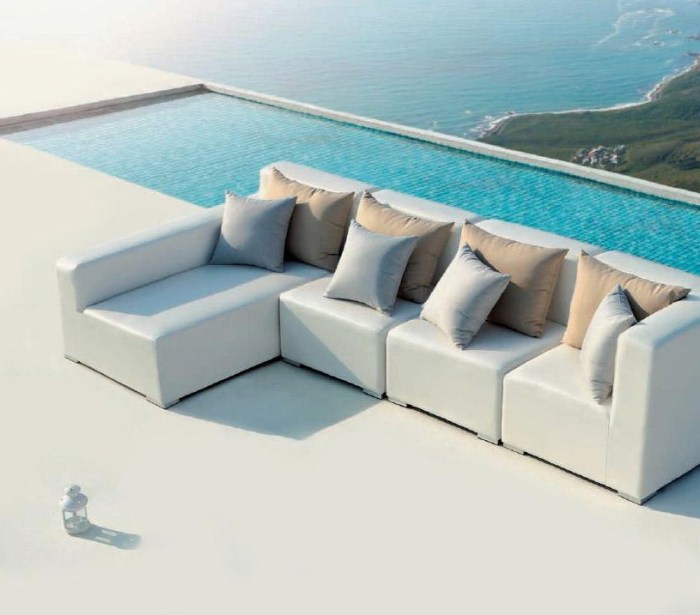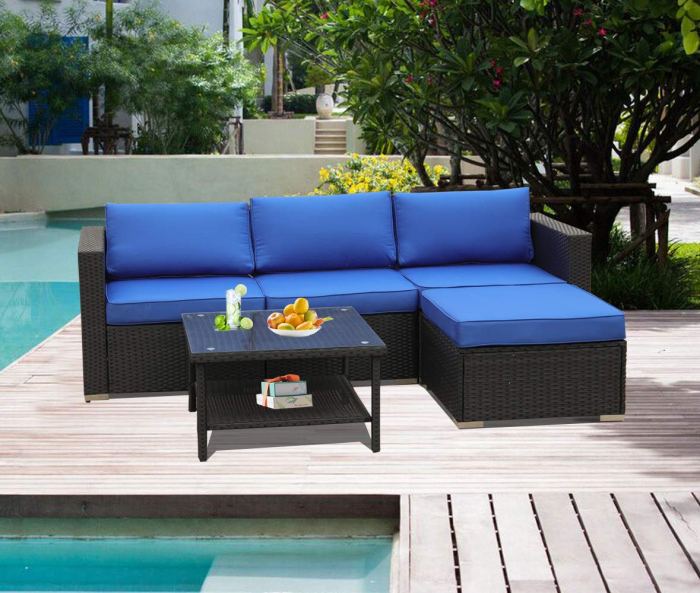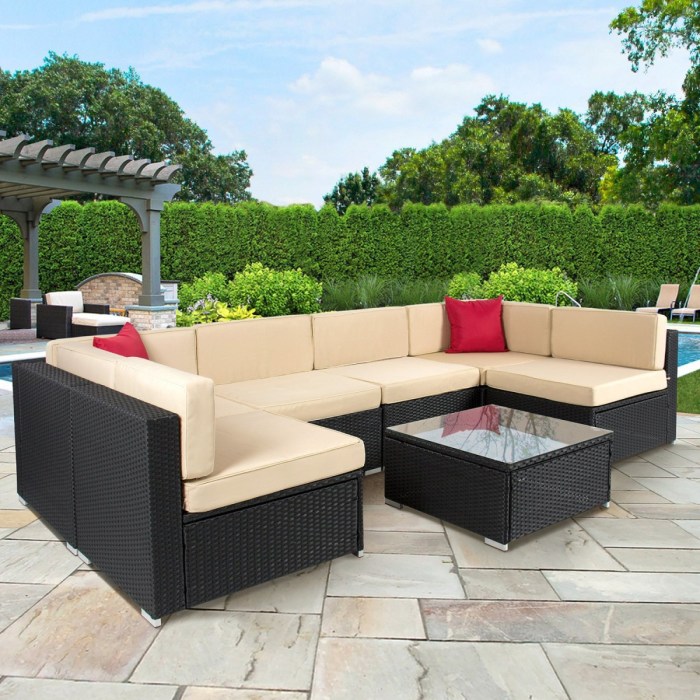Commercial Outdoor Sectional A Comprehensive Guide
Commercial outdoor sectional furniture is transforming outdoor spaces in restaurants, hotels, and community areas. This guide delves into the specifics of designing, implementing, and maintaining these durable and versatile pieces, covering everything from materials and construction to sizing and customization.
From understanding the diverse needs of commercial settings to exploring eco-friendly options, this comprehensive overview provides a deep understanding of commercial outdoor sectional design. We’ll analyze various materials, their durability, and maintenance requirements, as well as the crucial role these sections play in shaping the ambiance and overall experience of these spaces. The diverse applications and customizable nature of commercial outdoor sectional pieces will also be explored, alongside their market trends and pricing considerations.
Defining Commercial Outdoor Sectional
Commercial outdoor sectional furniture is designed for high-traffic, public spaces and demanding environments. These pieces are built to withstand the rigors of consistent use and exposure to the elements, unlike residential sections, which prioritize aesthetic appeal and comfort. Understanding the critical distinctions between commercial and residential options is essential for making informed purchasing decisions.
This comprehensive look at commercial outdoor sectional furniture will cover key features, materials, and design considerations, enabling a thorough grasp of the nuances between the two categories. From durable construction to weather resistance, this guide will equip you with the necessary knowledge to select the perfect piece for your specific needs.
Key Features of Commercial Outdoor Sectionals
Commercial outdoor sectionals are engineered for resilience. They boast reinforced frames, heavy-duty stitching, and superior weather-resistant fabrics. These features ensure longevity and maintain aesthetic appeal even under consistent use and exposure to harsh weather conditions. Often, commercial pieces are built to resist heavy use, frequent cleaning, and potential vandalism.
Durability and Design Considerations, Commercial outdoor sectional
Commercial outdoor sectional furniture prioritizes durability over purely aesthetic appeal. The design prioritizes robust construction, such as reinforced frames and thicker cushions. While aesthetics are still important, commercial pieces are less likely to feature intricate details that could be easily damaged. They are typically designed for long-term use and high-traffic environments, prioritizing functional robustness over intricate designs. Residential outdoor sectionals, in contrast, often emphasize decorative elements and comfort features.
Materials Used in Construction
A variety of materials are used in the construction of commercial outdoor sectionals. The selection of materials often depends on the intended use and budget.
- Aluminum: Aluminum frames are lightweight yet strong, offering excellent resistance to rust and corrosion. They are easy to maintain and generally durable. However, they may not be as resistant to impact damage as some other materials.
- Steel: Steel frames offer exceptional strength and durability, making them suitable for high-traffic areas. They can withstand significant weight and impact. However, steel can rust if not properly treated, requiring regular maintenance.
- Composite materials: Composite materials are becoming increasingly popular for their durability and weather resistance. They combine the best aspects of wood and plastic, offering a lightweight and resilient alternative to traditional materials. These are often a good value, but may not have the same aesthetic appeal as wood.
Styles and Designs
Commercial outdoor sectionals come in various styles to complement diverse design aesthetics. Modern, contemporary, and traditional options are available. Modern designs often feature clean lines and minimal embellishments, while contemporary styles incorporate more unique shapes and materials. Traditional designs frequently offer a classic, timeless appeal.
Weather Resistance and Maintenance
Weather resistance is paramount for commercial outdoor sectional furniture. High-quality fabrics and coatings are essential for protecting the furniture from fading, mildew, and water damage. Regular cleaning and maintenance, including periodic inspections of frames and cushions, are crucial for extending the lifespan of the sectional.
Applications and Settings

Source: walmartimages.com
Commercial outdoor sectional furniture is rapidly gaining popularity across diverse settings, transforming outdoor spaces into inviting and functional extensions of indoor areas. Its adaptability to various design aesthetics and functionality makes it a versatile choice for a wide array of commercial ventures. This adaptability allows businesses to cater to different customer needs and create a unique experience for their patrons.
The design and functionality of commercial outdoor sectional furniture are crucial in achieving a harmonious blend between aesthetics and practicality. Careful consideration of the intended use, the target audience, and the overall ambiance of the space is paramount. The key lies in tailoring the furniture to enhance the specific atmosphere and activities within each setting.
Restaurant Settings
Restaurants leverage outdoor sectional furniture to expand their seating capacity and create a more relaxed and inviting atmosphere. Sectional designs allow for flexible seating arrangements, accommodating groups of varying sizes. Materials should resist staining, fading, and weathering for long-term use and easy maintenance. Tables and lighting can be strategically integrated to enhance the dining experience. Examples include restaurants with patios or outdoor seating areas that are designed to feel like an extension of the indoor dining experience.
Cafe Settings
Outdoor sectional furniture can be used in cafes to create a lively social space. The furniture’s design should reflect the cafe’s ambiance, be it modern, rustic, or contemporary. Comfortable seating is key, and durable materials are essential to withstand the daily wear and tear. The furniture should also enhance the cafe’s aesthetic and promote a sense of community. This could involve using sectional sofas with integrated coffee tables or smaller modular sections that allow for flexibility and adaptability to different layouts.
Hotel Settings
Hotels often use outdoor sectional furniture to create inviting lounge areas for guests. Outdoor sectional furniture provides a place for relaxation, socializing, and enjoying the amenities. Sectional sofas are ideal for large groups or for those who want to relax and unwind in a communal space. High-quality, weather-resistant materials are critical for maintaining the hotel’s reputation for quality and comfort. Materials like weather-resistant wicker, durable fabrics, or synthetic materials are perfect for hotels.
Community Spaces
Community spaces, such as parks, plazas, or event venues, can incorporate outdoor sectional furniture to enhance public gathering areas. Sectional furniture provides a designated area for relaxing, socializing, or holding informal meetings. This type of furniture should be designed to withstand harsh weather conditions and high-use environments. Considerations include the durability of the material, the ability to withstand various weather conditions, and the potential for easy cleaning and maintenance. Examples include community gardens, public parks, and plazas where communal seating is needed.
Impact on Ambiance and Experience
Outdoor sectional furniture significantly impacts the overall ambiance and experience in each setting. The right choice of furniture can create a welcoming and inviting atmosphere, encouraging interaction and relaxation. Factors like material selection, color schemes, and design aesthetics play a crucial role in setting the desired tone. For example, light-colored fabrics in a park can create a sense of openness and brightness, while darker colors can offer a sense of intimacy.
Table: Commercial Outdoor Sectional Furniture Applications
| Setting | Best Suited Sectional | Key Features | Desired Atmosphere |
|---|---|---|---|
| Restaurant | Durable, stain-resistant, modular sectional | Large seating capacity, weather-resistant materials, integrated tables | Relaxed, inviting, communal dining experience |
| Cafe | Comfortable, low-profile sectional with cushions | Durable fabrics, easy-to-clean surfaces, integrated coffee tables | Lively, social, community-oriented space |
| Hotel | High-quality, weather-resistant sectional sofas | Elegant design, comfortable cushions, weather-resistant materials | Inviting, luxurious, relaxing lounge area |
| Community Space | Sturdy, weather-resistant, low-maintenance sectional | Large seating capacity, durability, easy cleaning | Community-focused, welcoming, public gathering space |
Durability and Construction

Source: avetexfurniture.com
Commercial outdoor sectional furniture faces rigorous conditions, demanding exceptional durability. The construction methods and materials employed directly impact the longevity and resilience of these pieces. Careful consideration of these factors is critical for maintaining the furniture’s quality and aesthetic appeal over time.
Construction Methods for Strength and Longevity
Commercial outdoor sectional furniture often utilizes robust framing systems, typically constructed from powder-coated aluminum, stainless steel, or treated hardwoods. These materials are selected for their strength, resistance to corrosion, and ability to withstand the stresses of outdoor use. Furthermore, the joints and connections are designed to ensure stability and prevent loosening or damage. Cross-bracing and reinforced corners are frequently incorporated to add structural integrity. This meticulous construction process is essential to guarantee the sectional’s long-term performance.
Materials Resistant to Weather Conditions
A variety of materials are utilized in the construction of commercial outdoor sectional furniture, each offering distinct benefits in terms of weather resistance. High-density polyethylene (HDPE) is a popular choice for cushions and seat backs due to its exceptional UV resistance and resistance to water absorption. Aluminum frames, treated with powder coatings, are highly resistant to rust and corrosion, ensuring longevity even in humid or saline environments. Furthermore, weather-resistant fabrics, often made from synthetic fibers, are used for upholstery, providing resistance to fading and mildew.
Importance of Assembly and Maintenance
Proper assembly and ongoing maintenance are crucial for extending the lifespan of commercial outdoor sectional furniture. Following the manufacturer’s instructions meticulously during assembly is essential to avoid potential structural issues. Regular cleaning and maintenance, such as wiping down surfaces and inspecting for any damage, can prevent deterioration and prolong the furniture’s life. Addressing any damage promptly, such as replacing worn cushions or repairing loose connections, is vital to maintaining the furniture’s quality.
Comparison of Durability Across Materials
The durability of different materials varies considerably. Aluminum frames, for example, are exceptionally resistant to rust and corrosion, offering a long lifespan. High-density polyethylene (HDPE) cushions are resistant to UV damage and water absorption, making them suitable for outdoor use. However, the durability of the wood frame, while strong, is often affected by moisture and needs to be properly treated to prevent decay. The specific durability of each material depends on factors like the quality of the material, the manufacturing process, and the environmental conditions.
Material Durability and Maintenance Requirements
| Material | Durability Rating | Maintenance Requirements |
|---|---|---|
| Aluminum | Excellent | Regular cleaning with mild detergent and water. Periodic inspection for signs of damage. |
| HDPE (High-Density Polyethylene) | Very Good | Regular cleaning with mild detergent and water. Protection from direct sunlight to prevent fading. |
| Treated Hardwood | Good | Regular cleaning with mild detergent and water. Periodic sealing to prevent moisture damage. |
Sizing and Customization
Commercial outdoor sectional furniture, unlike residential pieces, often needs to accommodate larger groups and diverse seating preferences. Proper sizing and customization are crucial for optimizing space utilization and meeting the specific needs of various commercial environments. Flexibility in configuration is paramount for adapting to changing group dynamics and event requirements.
Commercial outdoor sectional furniture is frequently used for gatherings and events in various settings. Consequently, it is critical to consider factors that influence the overall sizing and configuration. These considerations ensure the furniture is not only aesthetically pleasing but also functional and durable. Different spaces will necessitate different configurations, ensuring that the sectional maximizes the potential of the area while catering to the specific needs of the space and users.
Factors Influencing Sizing and Configuration
The size and configuration of commercial outdoor sectional furniture are influenced by several key factors. These include the anticipated number of guests, the available space, the intended use of the furniture, and the desired aesthetic. Consideration of these factors ensures optimal functionality and a visually appealing design. Modular designs are often preferred to allow for flexibility in adapting to evolving needs.
Seating Needs and Preferences
Accommodating different seating needs and preferences in commercial settings is vital. This includes considerations for various body types, accessibility requirements, and potential for different activity levels within the space. The ability to adjust the sectional to meet diverse needs ensures a positive user experience. This consideration can range from accommodating wheelchairs or other mobility aids to offering diverse seating options to suit different preferences. For instance, a combination of armchairs, loveseats, and ottomans can provide flexibility in seating arrangements.
Configurations and Arrangements for Various Group Sizes
Different configurations and arrangements are crucial for accommodating various group sizes. A modular sectional allows for easy reconfiguration, transforming a simple row into a large, communal seating area or multiple smaller, distinct zones. The ability to adapt to different needs is critical. For example, a large gathering may benefit from a continuous seating arrangement, while smaller meetings might require a more intimate grouping.
Modular Sectional Designs
Modular sectional designs offer unparalleled customization options for diverse spaces. These designs typically use a series of independent, interchangeable components that can be arranged in numerous ways to suit the specific layout and aesthetic of any commercial outdoor space. Such flexibility is key for accommodating diverse settings. This adaptability makes modular designs the most popular option for commercial settings. For instance, a set of interconnected modules can easily create a large U-shaped seating arrangement or several smaller, independent seating groups.
Examples of Modular Sectional Designs
| Sectional Size | Seating Capacity | Suitable Space Dimensions | Potential Layouts |
|---|---|---|---|
| Large (12 ft. x 8 ft.) | 20+ | Open-air patio (minimum 15 ft. x 10 ft.) | U-shape, L-shape, or continuous rows |
| Medium (8 ft. x 6 ft.) | 12-16 | Balcony or smaller patio (minimum 10 ft. x 8 ft.) | L-shape, two rows facing each other, or a combination of loveseats and armchairs |
| Small (6 ft. x 4 ft.) | 6-8 | Small patio or alcove (minimum 8 ft. x 6 ft.) | Two rows, a small U-shape, or a combination of smaller modules |
Pricing and Market Trends

Source: bestsofareview.com
Commercial outdoor sectional furniture pricing is a complex interplay of factors, ranging from the raw materials used to the level of customization desired. Understanding these elements is crucial for both businesses seeking to purchase and those aiming to offer competitive pricing. Market trends are constantly shifting, demanding adaptability and a keen eye for emerging design styles and consumer preferences.
Pricing Factors Influencing Cost
Several key factors directly impact the cost of commercial outdoor sectional furniture. Material selection is paramount, with high-quality, weather-resistant fabrics and durable aluminum or stainless steel frames commanding higher prices than less robust alternatives. Construction techniques, including the number and type of seams, the quality of stitching, and the use of reinforced components, also influence pricing. Customization plays a significant role. Businesses frequently require unique configurations, special finishes, or added features like built-in lighting or power outlets, all contributing to the overall cost. Importantly, pricing often reflects the brand reputation and the manufacturing processes used, with established brands and premium production methods typically associated with higher price points.
Market Trends and Emerging Designs
The market for commercial outdoor sectional furniture is evolving, reflecting contemporary design aesthetics and the growing demand for versatility. A trend toward modularity is evident, allowing for flexible arrangements and adaptation to diverse space requirements. Integrated functionality, such as built-in storage or charging stations, is increasingly popular, enhancing the practicality and appeal of these pieces. Sustainable materials, like recycled aluminum or reclaimed wood, are gaining traction, aligning with environmentally conscious design choices. Color palettes are expanding to incorporate bolder, more vibrant shades, while the use of textured fabrics and unique patterns adds visual appeal.
Pricing Models and Variations
Pricing models for commercial outdoor sectional furniture often vary by supplier and depend on the specific needs of the buyer. Some providers offer tiered pricing based on the size and configuration of the sectional. Others may use a per-item pricing structure, where individual components like cushions, frames, or bases are priced separately. Value-added services, such as design consultations, delivery, and installation, may also be factored into the final price. In addition, volume discounts are common for larger purchases, encouraging bulk orders and further reducing the per-unit cost.
Current Market Demand
The current market demand for commercial outdoor sectional furniture is robust, driven by the increasing popularity of outdoor spaces for both work and leisure. Businesses are seeking furniture that enhances their outdoor environments, creating comfortable and inviting spaces for employees and clients. Public spaces, such as restaurants, hotels, and community centers, are also adopting outdoor seating solutions, fueling the demand for durable, aesthetically pleasing, and functional options.
Pricing Model Table
| Material | Size (ft²) | Features | Estimated Price ($) |
|---|---|---|---|
| Aluminum Frame, Polyester Fabric | 12 | Standard cushions, basic design | $3,000 – $4,500 |
| Stainless Steel Frame, Sunbrella Fabric | 18 | Modular design, integrated lighting | $5,000 – $8,000 |
| Reclaimed Wood Frame, Canvas Fabric | 24 | Customizable cushions, built-in charging station | $8,000 – $12,000 |
Note: Prices are estimates and may vary based on specific configurations, customization, and location.
Maintenance and Cleaning
Proper maintenance and cleaning are crucial for extending the lifespan and preserving the aesthetic appeal of commercial outdoor sectional furniture. Regular care prevents premature wear and tear, maintaining the high-quality standards expected from commercial-grade products. This proactive approach safeguards your investment and ensures the furniture remains a valuable asset for years to come.
Maintaining a pristine appearance and ensuring longevity for these sections requires a diligent approach. Neglecting regular cleaning can lead to damage from weather exposure and accelerated deterioration, impacting both the structural integrity and the overall visual appeal of the furniture.
Cleaning Frequency
Regular cleaning is key to preventing buildup of dirt, grime, and other contaminants. This proactive measure safeguards the furniture’s finish and extends its useful life. How frequently you clean will depend on the specific environment and usage patterns. For high-traffic areas or locations with frequent exposure to harsh weather conditions, weekly or bi-weekly cleaning may be necessary. In less demanding settings, monthly cleaning may suffice. Keeping the furniture clean on a regular schedule will greatly reduce the need for more intensive cleaning sessions later on.
Material-Specific Cleaning Methods
Different materials require unique cleaning techniques. Understanding these nuances is vital for preserving the furniture’s condition.
- Fabric-covered sections: For fabric-covered sections, a soft-bristled brush or vacuum cleaner attachment can remove loose debris. Mild detergent solutions can be used for spot cleaning, ensuring the solution is diluted appropriately to prevent damage. Thorough rinsing and air drying are essential to avoid water spots or discoloration. Avoid harsh chemicals or abrasive scrubbing, as these could damage the fabric or its protective finish.
- Wicker or rattan: Wicker and rattan sections are susceptible to mildew and dirt buildup. A gentle hose or garden sprayer can effectively remove dust and debris. A soft-bristled brush can be used to loosen stubborn dirt, followed by a thorough rinse. Allow the furniture to dry completely in a well-ventilated area to prevent moisture damage.
- Aluminum or metal frames: For aluminum or metal frames, a mild detergent solution can be used for cleaning. A soft cloth or sponge can be employed for application. Thorough rinsing and drying are crucial to prevent rust or corrosion.
Protecting from the Elements
Protecting outdoor furniture from the elements is critical for longevity. This protection includes safeguarding the furniture from harsh sunlight, rain, and extreme temperatures.
- UV Protection: Using UV-resistant covers or storing the furniture in a covered area during periods of intense sunlight can protect the furniture from fading and degradation. Exposure to prolonged sun exposure can cause discoloration and material breakdown.
- Weatherproofing: Ensuring that the furniture is properly treated with water-repellent or weather-resistant finishes is paramount to maintaining its structural integrity and aesthetic appeal. The use of protective coatings is essential for outdoor applications to withstand the harshest weather conditions.
Preventing Damage
Preventive measures can significantly extend the lifespan of your commercial outdoor sectional furniture. Proactive maintenance prevents costly repairs and ensures the furniture’s structural integrity and aesthetic appeal remain intact.
Steps for Proper Cleaning and Maintenance:
- Regularly inspect the furniture for any signs of damage or wear.
- Remove loose debris, such as leaves, twigs, or dust, with a brush or vacuum.
- Use a mild detergent solution for spot cleaning and cleaning the frame, and rinse thoroughly.
- Allow the furniture to dry completely in a well-ventilated area before storing.
- Use weather-resistant covers to protect the furniture from the elements.
Tips for Extending Lifespan:
- Avoid leaving the furniture exposed to extreme temperatures for prolonged periods.
- Store the furniture indoors during harsh weather conditions.
- Regularly check for any signs of structural damage or deterioration.
Closing Summary: Commercial Outdoor Sectional

Source: patiotable.co
In conclusion, commercial outdoor sectional furniture is a powerful tool for creating inviting and enduring outdoor spaces. By considering factors such as durability, customization, and environmental impact, businesses can make informed decisions to enhance their spaces while aligning with current market trends. This comprehensive guide has provided a framework for understanding the essential elements that contribute to the successful integration of commercial outdoor sectional furniture into a variety of settings.





